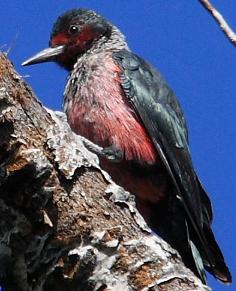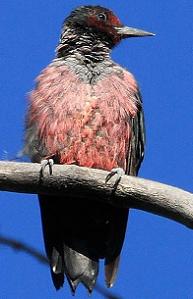Lewis's Woodpecker 
Identification and Pictures
(Melanerpes lewis)
Lewis's woodpecker named for Meriwether Lewis, is
a large dark woodpecker about 10 inches, with a blackish-green
back, and wings, a pink belly, and a gray collar. The head
is black with a red patch on the face. They have a large
pointed bill. The sexes are similar. Young birds
have the dark back, and wings but have brown heads, no red on
the faces, no gray collar, and they are mottled brown beneath.
The wings are broader than most woodpeckers and they have a
straight flight with slow even strokes like a crow.
Similar birds are the Red-Headed and Acorn
woodpeckers.
Photos by Keith
Lee. The camera I use is the Canon
EOS 40D. Visit All-birds store

Sound
The call of Lewis's woodpecker is a harsh
chee-ur. They also make high ik-ik-ik sound and a dry
rattling.
Preferred Habitat
Lewis's woodpecker is found from British Columbia and southwestern Alberta
through the western U.S. and into northern Mexico. They like
logged forests, and river groves preferring large scattered
trees to dense forests. Northern populations may migrate
for winter, while southern birds are resident year long.
Breeding and Nesting
Drumming during courtship is a weak roll followed by several taps.
To attract a mate, and to warn intruders the male points his
bill, and does a raised wing display, flashing his pink under
parts. Lewis's Woodpeckers are monogamous, and pairs for
long term bonds. The nest is a cavity excavated in a
dead tree branch, and will usually be reused each season.
They may reuse a cavity excavated by other birds. The
cavity is lined with wood chips, and the female will lay 6 to 8
white eggs. Both birds will incubate them for around 12
days. Both parents feed the young birds which will leave
the nest in 4 to 5 weeks. The fledglings will remain
around the nest, and be fed by the parents for roughly a week.
Food
Their main diet is insects such as ants, bees,
grasshoppers, and beetles, but they also eat nuts, and
berries. In addition to foraging for insects on trees
and, branches these birds will sit on top of a tree, or poll, and
fly out to catch insects. They also break up nuts, and acorns,
and store them in holes, and cracks in trees, and polls for
winter. They defend these winter stores
aggressively. They will also visit suet feeders.
To learn about other favorite
birds click here.

|
